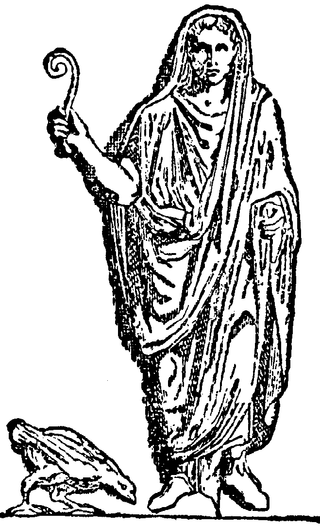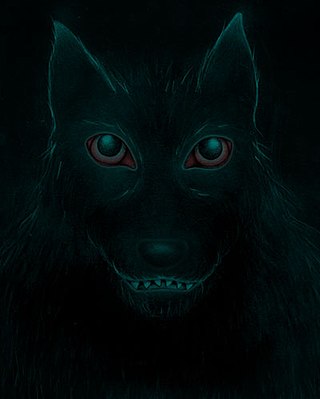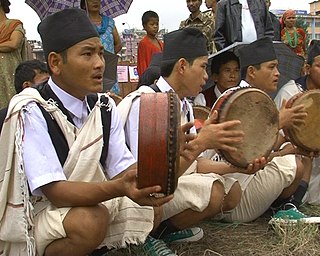
An augur was a priest and official in the classical Roman world. His main role was the practice of augury, the interpretation of the will of the gods by studying events he observed within a predetermined sacred space (templum). The templum corresponded to the heavenly space above. The augur's decisions were based on what he personally saw or heard from within the templum; they included thunder, lightning and any accidental signs such as falling objects, but in particular, birdsigns; whether the birds he saw flew in groups or alone, what noises they made as they flew, the direction of flight, what kind of birds they were, how many there were, or how they fed. This practice was known as "taking the auspices". As circumstance did not always favour the convenient appearance of wild birds or weather phenomena, domesticated chickens kept for the purpose were sometimes released into the templum, where their behaviour, particularly how they fed, could be studied by the augur.

An omen is a phenomenon that is believed to foretell the future, often signifying the advent of change. It was commonly believed in ancient times, and still believed by some today, that omens bring divine messages from the gods.

The king asleep in mountain is a prominent folklore trope found in many folktales and legends. Thompson termed it as the Kyffhäuser type. Some other designations are king in the mountain, king under the mountain, sleeping hero, or Bergentrückung.

In the indigenous religion of the ancient Tagalogs, Bathalà/Maykapál was the transcendent Supreme God, the originator and ruler of the universe. He is commonly known and referred to in the modern era as Bathalà, a term or title which, in earlier times, also applied to lesser beings such as personal tutelary spirits, omen birds, comets, and other heavenly bodies which the early Tagalog people believed predicted events. It was after the arrival of the Spanish missionaries in the Philippines in the 16th century that Bathalà /Maykapál came to be identified with the Christian God, hence its synonymy with Diyós. Over the course of the 19th century, the term Bathala was totally replaced by Panginoón (Lord) and Diyós (God). It was no longer used until it was popularized again by Filipinos who learned from chronicles that the Tagalogs' indigenous God was called Bathalà.

Augury was a Greco-Roman religion practice of observing the behavior of birds, to receive omens. When the individual, known as the augur, read these signs, it was referred to as "taking the auspices". "Auspices" means "looking at birds". Auspex, another word for augur, can be translated to "one who looks at birds". Depending upon the birds, the auspices from the gods could be favorable or unfavorable. Sometimes politically motivated augurs would fabricate unfavorable auspices in order to delay certain state functions, such as elections. Pliny the Elder attributes the invention of auspicy to Tiresias the seer of Thebes.

In English folklore, Black Shuck, Old Shuck, Old Shock or simply Shuck is the name given to a ghostly black dog which is said to roam the coastline and countryside of East Anglia, one of many such black dogs recorded in folklore across the British Isles. Accounts of Black Shuck form part of the folklore of Norfolk, Suffolk, the Cambridgeshire Fens and Essex, and descriptions of the creature's appearance and nature vary considerably; it is sometimes recorded as an omen of death, but, in other instances, is described as companionable.

Philippine mythology is rooted in the many indigenous Philippine folk religions. Philippine mythology exhibits influence from Hindu, Muslim, Buddhist, and Christian traditions.
Datu Kalantiaw is a widely publicized pseudohistorical figure based on an early 20th-century hoax by José Marco. Kalantiaw was credited with allegedly creating the first legal code in the Philippines, known as the Code of Kalantiaw in 1433. He gained national prominence in the 20th century in the Philippines, particularly in the island of Panay where allegedly held office.

The lightning bird or impundulu or thekwane is a creature in the folklore of the Zulu people.

A damphu, or damfoo, is a percussion instrument similar to a large tambourine. This instrument is used by the Tamang people of Nepal to play the melodious Tamang Selo. According to folklore Damphu was invented by Peng Dorje, a Tamang King and named it after Nepal's national bird the Daphne bird. It is also played by the gurung and magar people of nepal.

The black dog is a supernatural, spectral, or demonic hellhound originating from English folklore, and also present in folklore throughout Europe and the Americas. It is usually unnaturally large with glowing red or yellow eyes, is often connected with the Devil, and is sometimes an omen of death. It is sometimes associated with electrical storms, and also with crossroads, barrows, places of execution and ancient pathways.
The Aklanon people are the ethnolinguistic group who lived in the province of Aklan. They are part of the wider Bisaya ethnolinguistic group, who constitute the largest Filipino ethnolinguistic group.

Many references to ravens exist in world lore and literature. Most depictions allude to the appearance and behavior of the wide-ranging common raven. Because of its black plumage, croaking call, and diet of carrion, the raven is often associated with loss and ill omen. Yet, its symbolism is complex. As a talking bird, the raven also represents prophecy and insight. Ravens in stories often act as psychopomps, connecting the material world with the world of spirits.
Spearfinger, or U'tlun'ta', is a monster and witch in Cherokee legend, said to live along the eastern side of Tennessee and western part of North Carolina. U'tlun'ta is Cherokee for "the one with the pointed spear”. Her right forefinger resembles a spear or obsidian knife, which she uses to cut her victims. Her mouth is stained with blood from the livers she has eaten. She is also known as Nûñ'yunu'ï, which means "Stone-dress", for her stone-like skin. Often she clutches her right hand tightly, because she is hiding her heart and her only weak spot, which is her right palm.

The Inner and Outer Hebrides off the western coast of Scotland are made up of a great number of large and small islands. These isolated islands are the source of a number of Hebridean myths and legends. The Hebridean Islands are a part of Scotland that have always relied on the surrounding sea to sustain the small communities which have occupied parts of the islands for centuries, resulting in a number of sea legends relating to these local islands.

In Philippine mythology, the Tigmamanukan was believed by the Tagalog people to be an omen or augural bird. Although the behaviors of numerous birds and lizards were said to be omens, particular attention was paid to the tigmamanukan. Before Christianisation, the Tagalogs believed that the tigmamanukan was sent by Bathala to give hints to mankind whether they needed to proceed on a journey or not. In some Philippine creation myths, the tigmamanukan bird was sent by Bathala to crack open the primordial bamboo whence the first man and woman came out.

White horses have a special significance in the mythologies of cultures around the world. They are often associated with the sun chariot, with warrior-heroes, with fertility, or with an end-of-time saviour, but other interpretations exist as well. Both truly white horses and the more common grey horses, with completely white hair coats, were identified as "white" by various religious and cultural traditions.
The Code of Rajah Kalantiaw was a supposed legal code in the epic history Maragtas that is said to have been written in 1433 by Datu Kalantiaw, a chief on the island of Negros in the Philippines. It is now generally accepted by historians that the documents supporting the existence and history of the code, according to some sources, "appear to be deliberate fabrications with no historical validity" written in 1913 by a scholar named Jose Marco as a part of a historical fiction titled Las antiguas leyendas de la Isla de Negros.
Jose E. Marco was a Filipino writer and forger who created some of the most infamous hoaxes and forgeries relating to Philippine history, producing artifacts purported to have come from the pre-colonial and Spanish eras such as the Code of Kalantiaw, touted as the first law code in the Philippines, and La Loba Negra, a novel supposedly written by Filipino proto-nationalist priest Jose Burgos which became part of the country's educational curriculum for decades.











